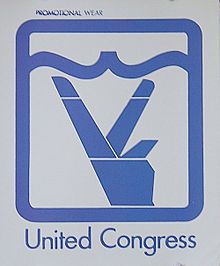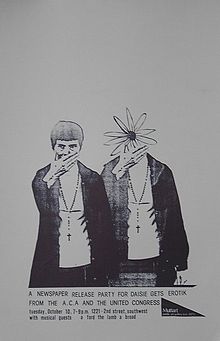- United Congress
-
Contents
The United Congress is a long-standing artist collective active in Calgary, Alberta. The group has combined conceptual art, silkscreen, music, constructed language, abstraction, propaganda and anti-art in its activities.
Alberta visual artist and original Congress member Lisa Brawn describes the group as "interested in dadaist instigation, politics, intense productivity, anonymity and relentless propagandizing” [1][2].
Beginnings
The United Congress was formed in 1988 at the Alberta College of Art and Design, by White-Field Senate, who is the group's longest-standing member [3]. Membership in the collective has always been loosely-knit and fluid. Earliest collective members were White-Field Senate, Lisa Brawn, Doug Nachtigall, Catherine Fisher, Connie Lambrecht, Andrea Ford, Elmer Xavier and Richard Farand, who has remained one of the group's most active artists [4].
Milo Dlouhy, Conroy Nachtigall, Kenneth Doren and Richard Cole also made contributions to the United Congress in its early days, and Dlouhy and Doren continue to be involved in Collective projects.[5][6][7][8][9]
Yuriko Iga, one-time director of Blim Gallery in Vancouver, has also contributed to the United Congress' recent projects in Calgary.[1][10]
Early Projects
The House of Israel
The House of Israel was an art event held in response to the desecration of a former downtown Calgary Synagogue by members of the Final Solution Skinheads, who covered the front of the building with white supremacist graffiti one night in November 1989.[2][3][11] The show made statements opposing all racist and anti-Semitic violence in Calgary, using music and visual art. The House of Israel show was set up shortly after the vandalism, at ACAD.[4]
The Castration of St. Paul
Probably the Congress' most notable public show was The Castration of St. Paul, at the Nickle Arts Museum on the University of Calgary campus in February/March, 1991.[5][12] The Castration was intended to critique what The United Congress considered the patriarchal nature of Christianity, and the show created "a virulent reaction" in the local press.[6] "The Castration of St. Paul" featured thirty low-resolution colour xerox enlargements of Polaroid photographs of naked male torsos. Each enlargement was carefully framed and labeled with the name of a historic Christian religious figure, including the twelve Apostles, seven Old Testament Prophets, five early Christian Saints, the Trinity, John the Baptist, Martin Luther, and Pope John Paul II.[7] Also part of the exhibit was a public lounge area featuring select pamphlets and literature promoting Christian organizations who espoused traditional values which the collective considered to be encouraging the subordination of females in family and public life.[7]
Other Projects
Early collective member Lisa Brawn describes the UC of the 1980s and early 1990s as producing "rapid-fire shows using video surveillance, nets, creamed marshmallow and red packing tape" and she jokes that the Congress took over the Alberta College of Art and Design "(l)ike a parasitic infestation."[13]
This period was very active for the United Congress, who assembled numerous shows on a variety of themes, including March 1989's One Hundred Pounds of Pretty Girls, God Save the Queen in April, 1989 at the Marion Nicholl Gallery, Montreal at the Illingworth-Kerr Gallery in 1992 [14], as well as CNIB, Recent Video Art by the United Congress (which contained no video art), The Sacred Shroud of Turin, and Our Ladies of Soul Sister. Each show was promoted by a run of hand-silkscreened posters distributed throughout the city [15].
The United Congress also collaborated with community groups to produce hand-screened posters for events such as Women Looking Forward's 1989 International Women's Day celebrations, and with the Calgary Jewish Centre for their multimedia presentation The Farthest Horizon: 100 years of Jewish Life in Alberta.
Publications
Daisiy Gets Erotik
This collective also took on the publication of the ACAD Magazine, and in Oct 1989 the first issue of Daisy Gets Erotik was hand silk-screened and made available. "Daisy" was considered controversial as an official student newspaper, as it featured nudity. Publication ceased after three issues [16][17].
Development of ISU
In the early 1990s, UC founder White-Field Senate developed a constructed language inspired by Dutton Speedwords. Called ISU (short for 'In Stat Ua' or 'International Language'), the developed language attempted to root out perceived inherent biases (such as gender hierarchies) in existing world languages. In 1996, the United Congress published a book on the topic: ISU: THE NEW WORLD LANGUAGE.[18]
Later Projects
United Missions
The United Congress collective briefly changed its name to United Missions in the mid-1990s, and for the 1997 Calgary ArtWeek Gala Bacchanal, presented Golden Boy, a show based on the personal artifacts of Rafael Albert, a Victorian cyclist.[8]
Comme des Congres
In 1999, The United Congress opened its Calgary street-front gallery, the Comme des Congres.[9] The gallery hosted several shows, notably Alberto Guedea's Re:<o><o> [19][20], ""an investigation of art creation using electronic mail as a tool"[21] , Hurting,[9] and Self-Maintenance,[9] which featured artist Carl Chapel George publicly attending to details of his personal hygiene, such as brushing his teeth, clipping his nails, plucking his eyebrows and ironing his clothes in view of gallery visitors and street-level passers by[9][22].
Related Projects
Colour For Industry
Sometime-United Congress-members Kenneth Doren, Conroy Nachtigall & Yuriko Iga, as well as Richard Farand work together occasionally in a different Calgary Artist collective. Colour For Industry combines digital opera, audio art, experimental music, modern dance and fabric arts to create works like Doren's celebrated Allegro Molto Con Brio King Kong, a 1999 Digital Opera focused on pop culture connections to the Greek myth of Prometheus whose performance incorporated a string quintet, three dancers and video monitors [23]
Sugar Estate Art Salon
Former Congress members Milo Dlouhy and Lisa Brawn collaborated on the Sugar Estate Art Salon Tea Room and Museum of Oddities, which existed from 2003 to 2004. The Salon "was formed to create an exquisite environment for interdisciplinary art exhibitions, performances, installations, etc."in Calgary.[24][25]
Articles
- Artcentral. Interview with an artist: Lisa Brawn [26]
- Garneau, David. "A week in the life...ArtWeek offers an excuse to sample Calgary's galleries and some special guests", Thursday, September 18., 1997: Vol. 2 #39 [27]
- Heintz, John W. Sr. Meditations on ‘The Castration of St. Paul’, vol2/no.2 Artichoke Magazine, 1991, pp 46–49: [28]
- Webb, Susy. Blim Gallery: Community Art is the New Dotcom, Discorder Magazine, Aug. 2004 [29]
- Wedderburn, Andrew. Pulling the curtain on window-front art:Public Display Act makes The United Congress wary of exposing themselves, ffwd weekly magazine, Aug 30, 2001 [30]
See also
- Appropriation (art)
- Art intervention
- Conceptual art
- Found art
- Modern art
- Neo-conceptual art
- Performance art
References
- ^ Webb, Susy. "Blim Gallery: Community Art is the New Dotcom", Discorder Magazine, Aug 2004
- ^ Bannerman, John. "Students turn vandals' target into work of art" Calgary Herald
- ^ Kinsella, Warren. Web of Hate, Harpercollins, 1994, ISBN 0002550741, p272
- ^ Heintz, John W. Sr. "Meditations on The Castration of St. Paul", vol2/no.2 Artichoke Magazine, 1991 p48
- ^ Heintz, John W. Sr. "Meditations on The Castration of St. Paul", vol2/no.2 Artichoke Magazine, 1991 pp46-49
- ^ Heintz, John W. Sr. "Meditations on The Castration of St. Paul", vol2/no.2 Artichoke Magazine, 1991 p49
- ^ a b Heintz, John W. Sr. "Meditations on The Castration of St. Paul", vol2/no.2 Artichoke Magazine, 1991 p46
- ^ Garneau, David. "A week in the life...ArtWeek offers an excuse to sample Calgary's galleries and some special guests", ffwd weekly magazine, Vol. 2 #39, 1997
- ^ a b c d Wedderburn, Andrew. Pulling the curtain on window-front art: Public Display Act makes The United Congress wary of exposing themselves ffwd weekly magazine, Aug 30, 2001
External links
Categories
Topics on Alberta History 
Politics Geography - Demographics
- Mountains
- Parks
- Lakes
- Rivers
Communities - Municipal districts (counties)
- Specialized municipalities
- Cities
- Towns
- Villages
- Summer villages
- Hamlets
- Indian reserves
- Métis settlements
- Census divisions
- Designated places
Economy - Companies
- Alberta Treasury Branch
- Tourism
- Highways
- Airports
Culture - Education
- Festivals
- First Nations
- Franco-Albertan
- Métis
- Music
- Sports
- People
- Symbols
- Flag
- Coat of arms
- Anthem
 Culture of Canada (by province or territory)
Culture of Canada (by province or territory)- Alberta
- British Columbia
- Manitoba
- New Brunswick
- Newfoundland and Labrador
- Nova Scotia
- Ontario
- Prince Edward Island
- Quebec
- Saskatchewan
- Northwest Territories
- Nunavut
- Yukon
Categories:- Culture of Calgary
- Canadian artist collectives
- Organizations based in Calgary
Wikimedia Foundation. 2010.


